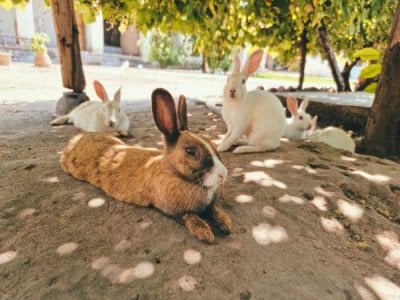Your town might be next! Discover the invasive threat causing Australia to lose millions!
By
Danielle F.
- Replies 15
Australia is a land of diverse ecosystems and unique wildlife, but it's also a battleground where invasive species wreak havoc on the environment and economy. One such invasive threat is multiplying at an alarming rate, and it's not just rural areas that are affected—Australian towns are now on the front line of a $197 million problem.
The issue at hand is the rabbit population, which has seen a dramatic increase in numbers, particularly on the outskirts of major cities. A recent photograph taken at Braeside Park, southeast of Melbourne, illustrates the severity of the situation. The image shows fields and bushland teeming with rabbits, a sight that has left locals astonished. One resident described the scene as 'thousands upon thousands' of the creatures, unlike anything they had ever witnessed.
Heidi Kleinert, the national rabbit management coordinator at the Centre for Invasive Species Solutions, has been closely monitoring this burgeoning problem. 'We’re seeing them move into towns,' she explained, attributing the population boom to consecutive years of wet springs and summers, which have provided 'great' breeding conditions for rabbits.

The impact of these furry invaders is far-reaching. Rabbits have been a persistent pest in Australia since their introduction in 1859, and they have since adapted to dominate the landscape. Covering two-thirds of the country, rabbits pose a significant threat to ecosystems and native species. Kleinert points out that rabbits disrupt more than just the local flora and fauna—they threaten as many as 322 native species, which is 'twice the number threatened by cats and foxes.'
The damage doesn't stop there. Rabbits also contribute to soil erosion and waterway degradation, compete with native animals for food and shelter, and cause a staggering $197 million in lost agricultural productivity annually. Their prolific breeding abilities, with pregnancies lasting around 30 days and the possibility of impregnation just hours after giving birth, make them formidable opponents in the fight to protect Australia's environment and economy.
The call to action is clear: every Australian must play a part in eradicating this invasive species. Kleinert remains optimistic, holding 'high hopes' that with a committed community effort, rabbits can be removed from the Australian landscape. However, she warns that this is not a 'fix-and-forget problem.' It requires a long-term, concerted effort involving cooperation with neighbours, government agencies, and a multi-faceted approach to eradication.
The Centre for Invasive Species Solutions offers a wealth of resources through its PestSmart website, providing property owners with the necessary tools to plan and manage an effective rabbit control program. Techniques such as baiting warrens, fumigation, and strategic weed removal are among the methods recommended to reduce the rabbit population and allow native species to recover.
Kleinert urges Australians to educate themselves on effective rabbit management strategies to ensure their efforts are not in vain. 'It's really hard work,' she admits, but with a clear vision and commitment, the country can overcome this invasive threat.

For more information on how to join the fight against rabbits and protect Australia's precious ecosystems, visit pestsmart.org.au. Together, we can tackle this issue and safeguard our environment for future generations.
The issue at hand is the rabbit population, which has seen a dramatic increase in numbers, particularly on the outskirts of major cities. A recent photograph taken at Braeside Park, southeast of Melbourne, illustrates the severity of the situation. The image shows fields and bushland teeming with rabbits, a sight that has left locals astonished. One resident described the scene as 'thousands upon thousands' of the creatures, unlike anything they had ever witnessed.
Heidi Kleinert, the national rabbit management coordinator at the Centre for Invasive Species Solutions, has been closely monitoring this burgeoning problem. 'We’re seeing them move into towns,' she explained, attributing the population boom to consecutive years of wet springs and summers, which have provided 'great' breeding conditions for rabbits.

Excessive number of wild rabbits may cause problems in the local ecosystem. Image Credit: Pexels/Wajid Khan
The impact of these furry invaders is far-reaching. Rabbits have been a persistent pest in Australia since their introduction in 1859, and they have since adapted to dominate the landscape. Covering two-thirds of the country, rabbits pose a significant threat to ecosystems and native species. Kleinert points out that rabbits disrupt more than just the local flora and fauna—they threaten as many as 322 native species, which is 'twice the number threatened by cats and foxes.'
The damage doesn't stop there. Rabbits also contribute to soil erosion and waterway degradation, compete with native animals for food and shelter, and cause a staggering $197 million in lost agricultural productivity annually. Their prolific breeding abilities, with pregnancies lasting around 30 days and the possibility of impregnation just hours after giving birth, make them formidable opponents in the fight to protect Australia's environment and economy.
The call to action is clear: every Australian must play a part in eradicating this invasive species. Kleinert remains optimistic, holding 'high hopes' that with a committed community effort, rabbits can be removed from the Australian landscape. However, she warns that this is not a 'fix-and-forget problem.' It requires a long-term, concerted effort involving cooperation with neighbours, government agencies, and a multi-faceted approach to eradication.
The Centre for Invasive Species Solutions offers a wealth of resources through its PestSmart website, providing property owners with the necessary tools to plan and manage an effective rabbit control program. Techniques such as baiting warrens, fumigation, and strategic weed removal are among the methods recommended to reduce the rabbit population and allow native species to recover.
Kleinert urges Australians to educate themselves on effective rabbit management strategies to ensure their efforts are not in vain. 'It's really hard work,' she admits, but with a clear vision and commitment, the country can overcome this invasive threat.
Key Takeaways
- Invasive rabbit populations in Australia are booming due to consecutive years of wet springs and summers, leading to an explosion in breeding conditions.
- The prolific breeding of rabbits is causing significant ecological disruption and threatens many native species, posing a greater threat than cats and foxes.
- This increase in rabbit populations is costing Australia $197 million annually in lost agricultural productivity.
- The national rabbit management coordinator at the Centre for Invasive Species Solutions calls for a long-term commitment from communities, property owners, and government agencies to effectively manage and work towards eradicating rabbits using various control methods.







